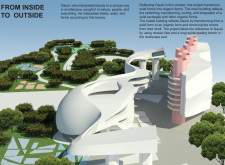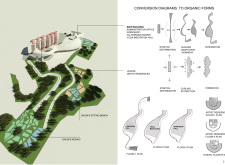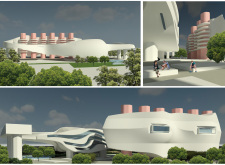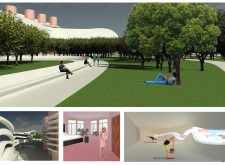5 key facts about this project
The architectural design draws inspiration from the works of Antoni Gaudí, incorporating solid and organic forms within its environment. Located in a setting that promotes a connection with nature, the building serves as both a main structure and a hostel. The overall design emphasizes adaptability, fluidity, and a sense of harmony with the landscape.
Design Concept
The central idea revolves around transitioning from traditional solid forms to shapes resembling those found in nature. The main building features a dynamic design, with a rectangular base that stretches, changes, and curls. This combination of forms highlights Gaudí's approach of blending structural strength with visual appeal. The design encourages occupants to interact with the environment in ways that go beyond conventional architectural boundaries.
Spatial Configuration
The hostel’s layout further illustrates the project's key ideas by moving away from typical room configurations. By eliminating the usual enclosure for individual rooms, the design creates a more open and flexible space. This arrangement allows for various uses and fosters collaboration among residents. Without rigid divisions, the space promotes a community-oriented living experience, reflecting modern trends in shared environments.
Materials and Aesthetic Elements
In line with Gaudí’s practices, the project includes specific materials that enhance its visual character. Mosaic tiles are used to add texture, drawing from traditional decorative styles. A long spiral seating bench is integrated into the landscape, establishing a link between the built environment and nature. These features contribute to a user-friendly experience and tie into the overall story conveyed by the building.
Key Concepts in Architectural Expression
Key ideas such as stretch, deformation, curling, adaptation, harmony, and integration deepen the relationship between structure and space. Each concept plays a role in responding to both the needs of people and the surrounding ecology. By focusing on organic forms and open layouts, the design contributes to ongoing discussions regarding sustainable architecture.
Light and shadow play across the surfaces, enhancing the building's forms and revealing the intricate patterns of the mosaic tiles. These elements invite exploration and reflection, enriching the experience within the spaces.





















































